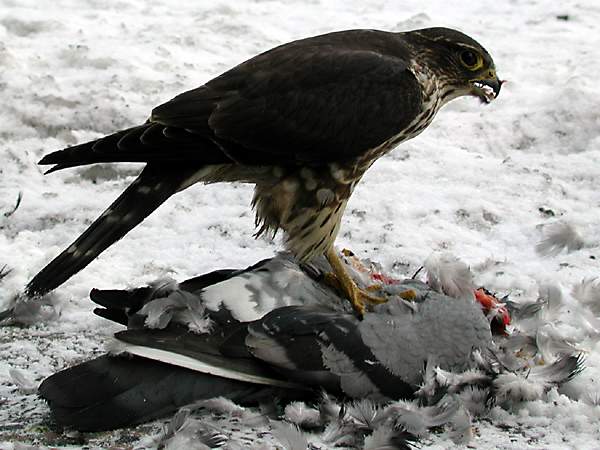
Raptor Identification - Merlin

If you have any photos of Merlins that you would like to contribute, please e-mail them to us with a caption and the photographer's name (but be aware that we must be selective of which photos we include because of space limitations for our website). |
Click on each photo for a description and a bigger picture
 |
 |
 |
 |
||||||
 |
 |
||||||||
 |
 |
 |
 |
||||||
 |
 |
 |
 |
||||||
 |
 |
 |
 |
||||||
 |
 |
 |
 |
||||||
 |
 |
 |

|
||||||
 |
 |
 |
 |
||||||
Merlin (Falco columbarius)
The Merlin is a relatively small falcon of the prairies, boreal forests, and subarctic areas of North America. Like the Peregrine, most races have a dark gray back, while immatures are brownish. However, they can easily be told apart
from Peregrines because their moustache is either narrow or absent, and because they are
considerably smaller (midway between a Kestrel and a Peregrine).
The following article about Merlins was reproduced (with modifications) from the November 2001 issue of CPF's Talon Tales. The article was written by Marcel Gahbauer.
|
Etymology: The merlin’s scientific name is Falco columbarius - a reference to its original North American name of "pigeon hawk", as columbarius means "pertaining to a dove or pigeon" in Latin. Unlike the peregrine which was formerly known as the "duck hawk" for its choice of prey, the name pigeon hawk alluded to the merlin’s pigeon-like flight. The Old French esmerillon is the root of both "merlin" and the modern French name for the species, "Faucon émerillon".
The merlin may also be confused with the American kestrel, which is only slightly smaller. A key behavioural difference is that merlins do not hover, while kestrels do so frequently. The kestrel is also much more colourful, and has two prominent black facial streaks. Closer in appearance to the merlin in terms of both size and colour is the sharp-shinned hawk. These species are best told apart by their wings: long and pointed on the merlin, and short and rounded on the sharp-shin. Habitat and distribution: The prairie merlin breeds in the aspen parkland and towns of the Canadian prairies and adjacent states. It is the palest of the three forms, especially on the underwings; it is also somewhat larger than the other races. Many prairie merlins, especially those living in urban areas, remain at their breeding territories throughout the year, but others may migrate as far as Mexico. The black merlin is a relatively uncommon resident of the Pacific coastal forest of British Columbia and southeast Alaska. As the name suggests, this race is very dark, with a nearly black cap, only faint tail bars, and almost solid dark underwings. Some black merlins move as far as California or New Mexico in winter, but others do not migrate. Natural history: Merlins have a voracious appetite. It has been estimated that during the breeding season a family of merlins consumes 24 kilograms of prey. The bulk of their diet is small songbirds. When hunting, the merlin typically flies over open forest or grassland at high speed (up to 70 km/h), flushing out birds and snatching individuals which react too slowly. Merlins are extremely agile in the air, able to make remarkably rapid changes of direction to keep up with their quarry. Alternatively, merlins may hunt by watching for activity from a perch, and then launching into rapid flight from there. Merlins also feed on insects, especially in migration when they often grab dragonflies or butterflies out of the air - snacks which they eat in flight without even slowing down! Conservation status: Another fascinating development is that the merlin is rapidly colonizing urban areas. It settled in Saskatchewan cities in the 1980s, and is now the most abundant raptor in most of the province’s urban areas. Over the past few years merlins have expanded into Ottawa, and are likely to soon appear in other Ontario cities. The success of the merlin is a great story in itself, and a good omen for the recovery of the peregrine. |
© Canadian Peregrine Foundation